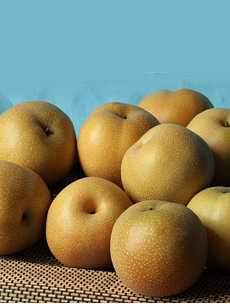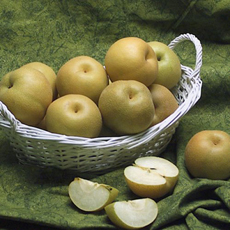TIP OF THE DAY: Asian Pears
|
Today’s tip is to try Asian pears. But don’t expect a creamy European pear texture or even a juicy apple texture, from the fruit that is also known as “apple pear” and “Korean pear,” among other names.*
“Asian pear” is the generic name for more than 25 different varieties† that originated in Asia. In ancient times the fruit was cultivated in what are now China, Japan and Korea. Asian pear is not a cross between apples and pears, as a name like “apple pear” suggests. That name was conferred because its shape and crisp texture are reminiscent of some varieties of apples. Don’t expect any apple flavor, either: The Asian pear is a true pear, of the genus Pyrus. |
|
|
|
Depending on the variety, Asian Pears may be considerably large or somewhat small. Their color may vary from yellow to brown, and their skin may be smooth or speckled. Although the outside appearance of each variety will differ, all Asian pears are crunchy and moderately sweet. Thought to have originally come to the U.S. via Chinese immigrants, Asian pears are now grown in California, Oregon and Washington, in addition to orchards worldwide.† Some of the most popular varieties grown in the U.S. include Hosui (Golden Russet Brown), Kosui (Golden Russet), Nijiseiki or Twentieth Century (Yellow-Green), Shinseiki (Yellow) and Shinsui (Russet Brown). *Names include apple pear, Asian pear, bae (Korean), Japanese pear, Korean pear, li (Chinese), nashi (Japanese; also nashi pear, nashipati or nashpati), sand pear and Taiwan pear. Asian pears are cultivated throughout East Asia, as well as in Australia, New Zealand and other countries. †The species include Pyrus pyrifolia, Pyrus ussuriensis, P. × bretschneideri, P. × sinkiangensis and P. pashia. Unlike the creamy flesh of Western pear varieties, |
||
 Asian pear varieties grown in the U.S. often have a yellow-brown hue with a tinge of green. Photo courtesy The Fruit Company. |
Chilled or cooked, Asian pears can add interest to any meal. The Asian pear is not baked into pies or made into chutney because it has a high water content and a signature grainy texture. It is commonly served raw and peeled, but we also enjoy them:
The pear genus is believed to have originated in present-day western China, in the foothills of the Tian Shan mountain range. It evolved into a diverse group of more than 20 widely primary species in Asia, and spread along mountain ranges in prehistoric times to the Middle East and then to Europe. |
|
|
There is firm evidence of prehistoric cultivation of pear trees in the Stone Age (beginning around 9500 B.C.E.), the period that begins with the rise of farming with stone tools and ending when metal tools engendered the Bronze Age (approximately 3500 B.C.E. to 2000 B.C.E.). As far back as 5000 B.C.E., Feng Li, a Chinese diplomat, became engrossed in grafting pears and other fruits as a commercial venture and switched careers. Early colonists brought the first pear trees to America’s eastern settlements, where they thrived until crop blights proved too severe to sustain widespread cultivation. Fortunately, the pear trees brought west to Oregon and Washington by pioneers in the 1800s thrived in the unique agricultural conditions found in the Pacific Northwest. Here‘s more on the history of pears from the Pear Bureau Northwest. |
||



